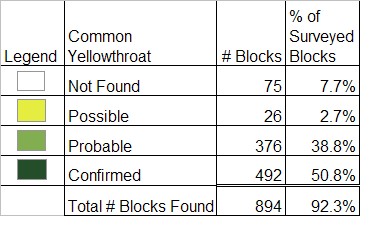Breeding Bird Atlases (BBA)
Find a Bird - BBA1
Breeding Bird Atlas 1 Species Accounts
Common Yellowthroat
Geothlypis trichas
Egg Dates
May 19 to June 27
Number of Broods
two

The Common Yellowthroat may be the best-known warbler breeding in Massachusetts due to its inquisitive behavior, a loud and recognizable song, the male’s distinctive plumage of a black mask and a bright yellow throat and chest, and its wide distribution throughout the Commonwealth. This warbler is found nesting in a wide variety of habitats, many characterized as both brushy and damp—swampy thickets, cattail marshes, overgrown meadows, and tangles near streams. The birds also utilize dry habitats such as roadside thickets, woodland clearings, and overgrown upland pastures. Seemingly, they occupy any small niche of suitable habitat, many of which are successional.
While most references stress the traditional relationship between yellowthroats and damp thickets, recent research has documented great concentrations of yellowthroats breeding in the Scrub Oaks of the sandy pinelands of southern Plymouth County, where the Prairie Warbler also occurs in high density. The attraction of this habitat appears to be the brushlike thickets of Scrub Oak and the openness of a canopy limited to scattered Pitch Pines. The highest breeding density recorded was 75 territories per one hundred acres unburned for 40 years. In contrast, a nearby coastal area that has the appearance of being good yellowthroat habitat has territories ranging from only 11 to 27 per 100 acres.
Yellowthroats generally begin to appear in early May. During spring flights, they may seem to be everywhere, although many of these birds are migrants that will move on. Banding has revealed that local breeding adults are the first to arrive and hold territories and transients bound for the North pass through a week or more later. Breeding yellowthroats are easy to find because the male sings his witchety-witchety-witchety or wee-chee-te, wee-chee-te, wee-chee-te song loudly and nearly continuously. Both sexes respond immediately to intruders with a scolding check or quit note and a rasping, chattering call, usually keeping close to the ground and cocking their tails in a wrenlike manner. The male has a less-known aerial flight song, a rapid jumble of short notes incorporating a few witchetys, most often given in the evening at a height of 10 to 15 feet. Both types of songs are heard regularly throughout July and sporadically to the end of August.
Despite the conspicuous behavior of the birds, the rather large and bulky nest is well hidden and difficult to find. It is built on or just above the ground in thick vegetation and sometimes over water. Details about nests in Massachusetts are scarce. Bent mentions two nests from Arlington built in Red Cedar. Six Worcester County nests were all on the ground and concealed in clumps of grass or weeds. All were in old fields and were 6 feet or less from a wood border or row of trees and saplings (Meservey). The cupped nest is constructed of leaves, grass, and bark strips and lined with fine grass and rootlets. The female incubates the clutch of three to five (rarely six) eggs for 12 days. Clutch sizes for 11 state nests were three eggs (1 nest), four eggs (10 nests) (DKW). Eggs have been recorded in the Commonwealth from mid-May to early July, but the data on young indicates that the range of egg dates should extend to late July. While some authors suggest that three broods may be reared, this appears to be rare and has not been documented in Massachusetts.
The altricial young are nearly naked at hatching. On the third day, the feather papillae are showing, and the eyes open on day 4. They are well feathered by day 8 and leave the nest at 9 or 10 days old. Both parents feed the young, and family groups remain together for some time after fledging occurs. The male will care for the first-brood young while the female initiates a second nesting. In Massachusetts, nestlings have been observed from June 10 to July 14 and fledglings from June 30 to August 9 (Nice 1933, Meservey). If the young are threatened, the adults often perform a distraction display, hopping about with quivering and spread wings. Following the postjuvenal molt, young birds closely resemble the adult females, with olive green upperparts and yellowish underparts. Adults have a complete molt in July and August. Yellowthroats are often victimized by cowbirds; a Brookfield nest contained two yellowthroat nestlings and one cowbird nestling on July 1 (Meservey).
Migrants are detected by mid-August, with the peak movement occurring between the third week of August and mid-September; migration continues well into October. This is one of the warbler species that most often lingers into early winter, with a few turning up each year on Massachusetts Christmas Bird Counts. Most Common Yellowthroats winter from the Carolinas south to Puerto Rico and Costa Rica.
Map Legend and Data Summary
Atlas 1 data collected from 1975-1979


Note: common to very common in moist thickets and brushy areas throughout the state
Kathleen S. Anderson



